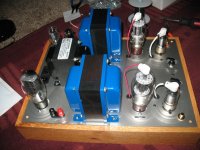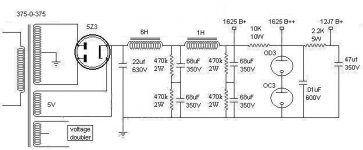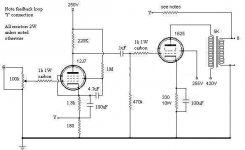It's been a long, long time since I've heard a single-ended pentode (SEP) amplifier. The popular thing to do is to use the 300B, but hey, I'm a cheapskate who still likes to use old tubes that are still as common as dirt. Enter the 1625 output tube and 12J7 driver which can still be had for a couple of bucks each. It's also been a few years since I've built a tube amp from scratch so it was even better when this amplifier worked from the very first time it was turned on.
Eagle eyed members of this site will recognize the general basics of this amplifier from a single-ended ultralinear design by Electraprint. Oddly enough that design wasn't my original inspiration, but instead it was the classic jc morrison SEUL 6L6GC. However I went with a higher B+, pentode connection, and a much different power supply cobbled together with some cheap Allied iron, Triad chokes, and VR regulation for the screens and input stage. Lots of the parts were also from my tub of "junk parts", so that's explains some of the odd part values. It also kept the build cost under $600.
LOTS of potential for improvements here - and I'm sure the usual suspects will weigh in for my mistakes or ways to make this simple amplifier even better. I can think of a couple of myself. But hey, the amp works and sounds quite nice as-is. I am, however, not too pleased with the quality of the Chinese ceramic plate caps for the 1625. I'll be hunting for some NOS versions instead - like I used for the 12J7. The UX4 Johnson Chinese ceramic socket isn't too great either, since it allowed me to plug in the tube 90 degrees off, resulting in some headscratching when the amplifier blew a fuse upon turn on.
I live in a fairly low RF area, but I would probably add in some type of plate stopper for the 1625. Full build details and some further listening tests against my rebuilt EICO HF-60s are on my blog.
6th Street Bridge: Project: The Command 1625 tube amplifier
Eagle eyed members of this site will recognize the general basics of this amplifier from a single-ended ultralinear design by Electraprint. Oddly enough that design wasn't my original inspiration, but instead it was the classic jc morrison SEUL 6L6GC. However I went with a higher B+, pentode connection, and a much different power supply cobbled together with some cheap Allied iron, Triad chokes, and VR regulation for the screens and input stage. Lots of the parts were also from my tub of "junk parts", so that's explains some of the odd part values. It also kept the build cost under $600.
LOTS of potential for improvements here - and I'm sure the usual suspects will weigh in for my mistakes or ways to make this simple amplifier even better. I can think of a couple of myself. But hey, the amp works and sounds quite nice as-is. I am, however, not too pleased with the quality of the Chinese ceramic plate caps for the 1625. I'll be hunting for some NOS versions instead - like I used for the 12J7. The UX4 Johnson Chinese ceramic socket isn't too great either, since it allowed me to plug in the tube 90 degrees off, resulting in some headscratching when the amplifier blew a fuse upon turn on.
I live in a fairly low RF area, but I would probably add in some type of plate stopper for the 1625. Full build details and some further listening tests against my rebuilt EICO HF-60s are on my blog.
6th Street Bridge: Project: The Command 1625 tube amplifier
Attachments
Just a few questions.
The power xfmr and the op xfmr cores are orientated in the same direction.
Usually the power xfmr is rotated 90-degrees but you didn't do it.
Is there ANY hum induction-problem because of this?
Is rotating the power xfmr just something people do because it 'should' be done?
No real consequences if you don't do it ...or are the cores here far enough apart to not cause problems?
Other than that: NICE!
What's the output?
rgds,
/tri-comp
The power xfmr and the op xfmr cores are orientated in the same direction.
Usually the power xfmr is rotated 90-degrees but you didn't do it.
Is there ANY hum induction-problem because of this?
Is rotating the power xfmr just something people do because it 'should' be done?
No real consequences if you don't do it ...or are the cores here far enough apart to not cause problems?
Other than that: NICE!
What's the output?
rgds,
/tri-comp
thanks all for the kind comments.
some answers to a few questions:
No, I haven't tried plate-to-plate feedback though that would be a nice experiment.
I know what you mean about transformer orientation - and boy, those Edcor transformers look huge compared to the cheap Allied (er, Hammond) iron. But no, the amp is very quiet with no hum issues. DC on the filaments probably helps too.
Power output is ~8Ws. It does drive Spica TC-50s rather well, and they are only 86dB efficient.
This amplifier is sort of a "contrarian" piece - single-ended pentode, loop feedback, and pentode driver - meant to explore a slightly less popular circuit. I imagined it as a "super radio output" if some audio nut from the 1940s wanted to build an amplifier for their radio receiver. It's also a fairly easy build and only took a few hours of time to wire up. However, with the additional regulator and voltage-doubler, I wouldn't necessarily recommend it for a beginner DIYer.
some answers to a few questions:
No, I haven't tried plate-to-plate feedback though that would be a nice experiment.
I know what you mean about transformer orientation - and boy, those Edcor transformers look huge compared to the cheap Allied (er, Hammond) iron. But no, the amp is very quiet with no hum issues. DC on the filaments probably helps too.
Power output is ~8Ws. It does drive Spica TC-50s rather well, and they are only 86dB efficient.
This amplifier is sort of a "contrarian" piece - single-ended pentode, loop feedback, and pentode driver - meant to explore a slightly less popular circuit. I imagined it as a "super radio output" if some audio nut from the 1940s wanted to build an amplifier for their radio receiver. It's also a fairly easy build and only took a few hours of time to wire up. However, with the additional regulator and voltage-doubler, I wouldn't necessarily recommend it for a beginner DIYer.
Some Suggestions
Second the use of plate to plate feedback, gets rid of the overall feedback around the output transformer. Also if you try plate to plate, you could lose the cathode cap on the input tube as well, of course this depends on the gain required. One less cap is a good thing in my experience. These mods are quick and easily reversed, if you don't like them. Each to his/her own sound
Ejam
Second the use of plate to plate feedback, gets rid of the overall feedback around the output transformer. Also if you try plate to plate, you could lose the cathode cap on the input tube as well, of course this depends on the gain required. One less cap is a good thing in my experience. These mods are quick and easily reversed, if you don't like them. Each to his/her own sound
Ejam
- Status
- This old topic is closed. If you want to reopen this topic, contact a moderator using the "Report Post" button.
- Home
- Amplifiers
- Tubes / Valves
- Using those dern 1625 tubes: a simple SEP amplifier


